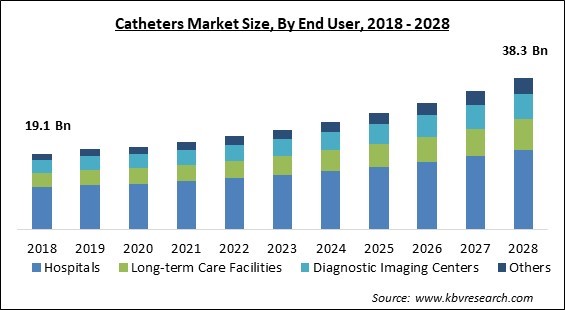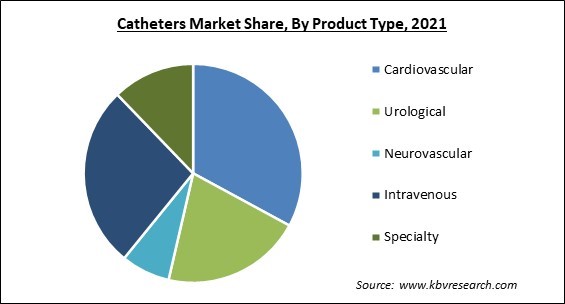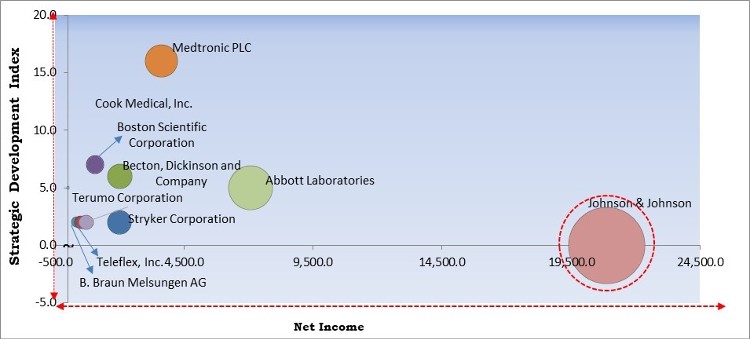The Global Catheters Market size is expected to reach $38.3 billion by 2028, rising at a market growth of 8.5% CAGR during the forecast period.
Catheters are required for patients who are receiving general medicine. Catheter-associated urinary tract infections (CAUTIs) and central line-associated blood infections can occur when catheters are used often (CLABSIs). Patients with chronic illnesses frequently have a weakened immune system and need to be admitted to hospitals regularly. Due to the frequent usage of the catheter to reach the blood vessels, the patients are at significant risk of infection. As a result, antimicrobial catheters were introduced to prevent catheter-associated infection and the rising number of cases of thrombosis. Medtronic's antimicrobial catheters with silver ion and Palindrome HSI-heparin coating are two famous examples.

A catheter is a narrow tube composed of medical-grade materials that serve a variety of roles in medicine. Catheters are medical equipment that is put into the body to treat the disease or to perform surgery. Catheters can be tailored for cardiovascular, urological, gastrointestinal, neurovascular, and ophthalmic uses by changing the material or changing the manner they're made. Catheterization is the process of placing a catheter.
The rise in the prevalence of cardiovascular disorders, as well as the desire for minimally invasive surgeries, is driving the catheter market forward. Furthermore, a large increase in the frequency of chronic diseases connected with the urinary bladder, kidney failures, and other reasons are driving the growth of the catheter market during the forecast period. Furthermore, an increase in patient desire for minimally invasive surgeries propels the catheter market forward.
In addition, the market is expected to develop due to the increase in incontinence issues as the world's geriatric population grows, as well as an increase in demand for sterilized and disposable catheters. Furthermore, the development of new catheters by a wide number of important manufacturers contributes to the market's expansion.
However, the expansion of the catheters market is fueled by an increase in the geriatric population and an increase in the number of people who suffer from bladder cancer. Moreover, due to recent technological advancements, the need for catheters is likely to rise as the desire for minimally invasive operations grows. For example, due to its least invasive nature, angioplasty is becoming more popular than traditional surgeries, which contributes to market growth.
Catheters are being used to treat people who have been diagnosed with COVID-19. Bactiguard, for example, introduced the BIP Foley TempSensor, a novel urinary catheter for continuous temperature monitoring, in April 2020. In June, the business announced that it has developed a urinary catheter with embedded monitoring of temperature and infection management. As a result, technological advances will aid to propel the catheters market forward over the forecast period. However, as the number of entries into the domestic market grows, the performance of catheter devices suffers as these manufacturers use low-cost, poor raw materials to produce low-cost products, limiting market expansion.
The catheter market is divided into single-lumen, double-lumen, triple-lumen, and other segments based on the lumen. In intravenous surgery, double-lumen catheters are commonly utilized for a variety of medical applications. These double lumen catheters are often composed of polyethylene or polyurethane, and they are simple to use and can be placed directly during procedures to provide independent venous access. Double-lumen catheters allow for the simultaneous injection of two unsuitable fluids or medicines. It has several advantages, including the best balance of mobility and endurance.
Cancer is the leading cause of death, with an estimated 10 million deaths predicted by 2020. Prostate cancer is the second most frequent malignancy in men and the fifth leading cause of death globally (1.41 million cases). Prostate cancer in its early stages is often asymptomatic and has a slow progression, requiring just attentive observation. Diagnostic testing is used differently around the world, resulting in differences in occurrence rates. Prostate cancer incidence and fatality rates are strongly connected to age, with the highest incidence recorded in older men. African-American men have the highest prevalence rate and a more aggressive form of prostate cancer than White men.

The most common consequence in people undergoing IC is urinary tract infection. In published research, however, the frequency of UTIs related to IC varies greatly. This could be determined by the evaluation methods utilized, such as different IC procedures, different urine measurement frequencies, different UTI criteria, the patient population studied, and so on. In 302 patients treated with Clean IC, Becka and Volset3 looked at characteristics that could predict the development of bacteriuria and clinical UTI (CIC). In women, low age and high mean catheterization volume were predictive variables of clinical UTI; in men, low age, neurogenic bladder dysfunction, and non-self-catheterization, as well as urine leakage in patients with neurogenic dysfunction, were predictive factors of clinical UTI.
Based on Product Type, the market is segmented into Cardiovascular, Urological, Neurovascular, Intravenous, and Specialty. The urological segment witnesses a significant revenue share in the catheters market in 2021. To empty the bladder and collect urine in a drainage bag, a urinary catheter is inserted into the bladder by a doctor or nurse. If a patient has difficulty peeing (urinating) naturally, urinary catheters are frequently used. They can be inserted through a small incision in stomach or via the tube that removes urine from the bladder.
Based on End User, the market is segmented into Hospitals, Long-term Care Facilities, Diagnostic Imaging Centers, and Others. The Hospital segment procured the largest revenue share in the catheters market in 2021. It is due to the increasing number of the hospital has surge the growth of the catheters. The growing hospital makes its more accessible for humans for the treatment and the operation procedure. People mostly depend on the hospital for the treatment which also tends in the adoption of the catheters while surgery in the hospitals.
| Report Attribute | Details |
|---|---|
| Market size value in 2021 | USD 22 Billion |
| Market size forecast in 2028 | USD 38.3 Billion |
| Base Year | 2021 |
| Historical Period | 2018 to 2020 |
| Forecast Period | 2022 to 2028 |
| Revenue Growth Rate | CAGR of 8.5% from 2022 to 2028 |
| Number of Pages | 228 |
| Number of Tables | 294 |
| Report coverage | Market Trends, Revenue Estimation and Forecast, Segmentation Analysis, Regional and Country Breakdown, Competitive Landscape, Companies Strategic Developments, Company Profiling |
| Segments covered | Product Type, End User, Region |
| Country scope | US, Canada, Mexico, Germany, UK, France, Russia, Spain, Italy, China, Japan, India, South Korea, Singapore, Malaysia, Brazil, Argentina, UAE, Saudi Arabia, South Africa, Nigeria |
| Growth Drivers |
|
| Restraints |
|

Based on Regions, the market is segmented into North America, Europe, Asia Pacific, and Latin America, Middle East & Africa. The Asia Pacific region registered a promising revenue share in the catheters market in 2021. It is attributable to a variety of causes like increased discretionary income, rising healthcare spending, and the presence of vast unexplored markets in emerging economies like India and China. Furthermore, a huge patient pool with kidney and cardiovascular issues, as well as improved medical facilities, are likely to drive significant market expansion in the region.
Free Valuable Insights: Global Catheters Market size to reach USD 38.3 Billion by 2028
The major strategies followed by the market participants are Product Launches and Approvals. Based on the Analysis presented in the Cardinal matrix; Johnson & Johnson is the forerunners in the Catheters Market. Companies such as Abbott Laboratories, Medtronic PLC and Becton, Dickinson and Company are some of the key innovators in the Market.
The market research report covers the analysis of key stake holders of the market. Key companies profiled in the report include Boston Scientific Corporation, Medtronic PLC, Johnson & Johnson, Becton, Dickinson and Company, Abbott Laboratories, B. Braun Melsungen AG, Stryker Corporation, Teleflex, Inc., Terumo Corporation, and Cook Medical, Inc.
By Product Type
By End User
By Geography
The catheters market size is projected to reach USD 38.3 billion by 2028.
Technological breakthroughs in double-lumen catheters are driving the market in coming years, however, increased chances of infection in the urinary tract limited the growth of the market.
Boston Scientific Corporation, Medtronic PLC, Johnson & Johnson, Becton, Dickinson and Company, Abbott Laboratories, B. Braun Melsungen AG, Stryker Corporation, Teleflex, Inc., Terumo Corporation, and Cook Medical, Inc.
The Cardiovascular segment acquired maximum revenue share in the Global Catheters Market by Product Type in 2021, thereby, achieving a market value of $11.4 billion by 2028.
The North America market dominated the Global Catheters Market by Region in 2021, and would continue to be a dominant market till 2028; thereby, achieving a market value of $13.4 billion by 2028.
Our team of dedicated experts can provide you with attractive expansion opportunities for your business.

